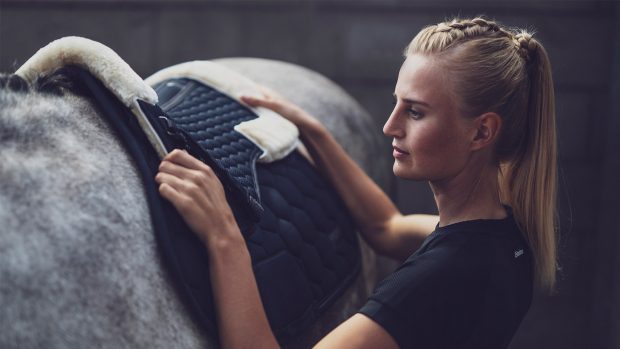View saddles for sale
Find a tackshop near you
More legal advice concerning equestrian equipment
Q: I bought a numnah and the tackshop embroidered my horse’s name on to it. Back home we tried it on with the saddle, but the embroidery was covered up and it barely fitted.
We took it back, and the retailer got out a small saddle and tried it on with the numnah, claiming the problem was our fault, not theirs. The lady told us it was full size.
Are we legally entitled to have the numnah replaced?
ST, West Midlands
Alison Goodwin, director of the tackshop in question, Diamond Saddlery, recalls an adult purchasing a saddlecloth which was embroidered with the eight letters of her son’s horse’s name.
“The lady returned the cloth explaining the saddle obscured part of the embroidery,” said Alison. “This seemed unusual, as we embroider many cloths, and are aware of leaving space for the saddle flap. I asked about the make of the saddle, style and size, and put the saddlecloth under a 17in GP saddle in the store. It was OK. I also asked the customer to pop back with the cloth and her own saddle so I could assess the problem.
“We need to know whether the saddlecloth is the incorrect size for the saddle, or whether we have stitched it incorrectly,” she explained. “However, the customer has not returned to allow us to find a solution, and we have not received any correspondence regarding this.
“This situation is extremely unusual — our in-store embroidery staff are very experienced and embroider many items on a regular basis.”
Buyers have certain statutory rights under the Sale of Goods Act and the Sale and Supply of Goods to Consumers Regulations. A buyer should expect a purchased product to be of a satisfactory quality, must be “as described” on the advertising, label or in-house promotional information, and should also be “fit for purpose”.
Where a fault occurs within six months of purchase, and when the customer requests a repair or replacement, the buyer does not have to prove the fault exists. The trader must prove the goods were not faulty. However, circumstances can affect such a claim, for example if the seller believes the customer examined the item before purchase, and checked its sizing.
Executive director of the British Equestrian Trade Association (BETA), Claire Williams, says in cases of a dispute, BETA normally refers people to the Trading Standards Institute.
“If the trader in question is a BETA member, we can offer to arbitrate a solution for both parties,” said Claire.
Information
www.tradingstandards.gov.uk
Looking for saddles for sale?
Need legal advice concerning your equestrian equipment?
Looking for a tackshop near you?



